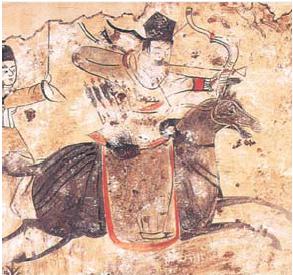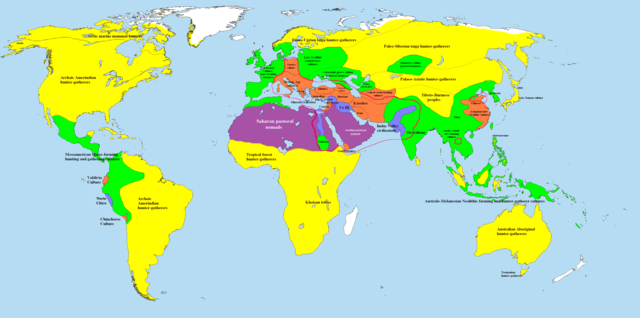
| ANCIENT HISTORY
The Parthenon on the Athenian Acropolis, built of marble and limestone between circa 460-406 BC, is a symbol not just of Ancient Greek architecture, but for Antiquity in general Preceded by :
prehistory
Near East :
Sumer, Egypt, Elam, Akkad, Assyria, Babylonia, Mitanni, Hittites, Sea Peoples, Anatolia, Israel and Judah, Arabia, Berbers, Phoenicia, Persia
Europe :
Minoans, Greece, Illyrians, Argaric, Nuragic, Tartessos, Iberia, Celts, Germanics, Etruscans, Rome, Slavs, Daco-tdracians
Eurasian Steppe :
Proto-Indo-Europeans, Afanasievo, Indo-Iranians, Scytdia, Tocharians, Huns, Xionites, Turks
East Asia :
China, Japan, Korea, Mongolia
South Asia :
Indus Valley Civilisation, Vedic period, Mahajanpads, Nand Empire, Maurya Empire, Sangam period, Middle Kingdoms, Gupta Empire
Mississippiand Oasisamerica :
Adena, Hopewell, Mississippian, Puebloans
Mesoamerica :
Olmecs, Epi-Olmec, Zapotec, Mixtec, Maya, Teotihuacan, Toltec Empire
Andes :
Norte Chico, Sechin, Chav, Paracas, Nazca, Moche, Lima, Tiwanaku, Wari
West Africa :
Dhar Tichitt, Oualata, Nok, Senegambia, Djenné-Djenno, Bantu, Ghana Empire
Southeast Asia and Oceania :
Vietnam, Austronesians, Australia, Polynesia, Funan, Tarumanagara
Ancient history as a term refers to the aggregate of past events from the beginning of writing and recorded human history and extending as far as post-classical history. The phrase may be used either to refer to the period of time or the academic discipline.
The span of recorded history is roughly 5,000 years, beginning with the Sumerian cuneiform script, with the oldest coherent texts from about 2600 BC. Ancient history covers all continents inhabited by humans in the period 3000 BC – AD 500.
The broad term "ancient history" is not to be confused with "classical antiquity". The term classical antiquity is often used to refer to Western history in the Ancient Mediterranean from the beginning of recorded Greek history in 776 BC (first Olympiad). This roughly coincides with the traditional date of the founding of Rome in 753 BC, the beginning of the history of ancient Rome, and the beginning of the Archaic period in Ancient Greece.
The academic term "history" is not to be confused with colloquial references to times past. History is fundamentally the study of the past, and can be either scientific (archaeology) or humanistic (history through language).
Although the ending date of ancient history is disputed, some Western scholars use the fall of the Western Roman Empire in 476 AD (the most used), the closure of the Platonic Academy in 529 AD, the death of the emperor Justinian I in 565 AD, the coming of Islam, or the rise of Charlemagne as the end of ancient and Classical European history. Outside of Europe the 450–500 time frame for the end of ancient times has had difficulty as a transition date from ancient to post-classical times.
During the time period of ancient history (starting roughly from 3000 BC), the world population was already exponentially increasing due to the Neolithic Revolution, which was in full progress. According to HYDE estimates from the Netherlands, world population increased exponentially in this period. In 10,000 BC in prehistory, the world population had stood at 2 million, rising to 45 million by 3,000 BC. By the rise of the Iron Age in 1,000 BC, the population had risen to 72 million. By the end of the period in 500 AD, the world population is thought to have stood at 209 million. In 3,500 years, the world population increased by 100 times.
Study
:
Archaeology
:
•
The Egyptian pyramids : giant tombs built by the ancient Egyptians
beginning about 2600 BC as the final resting places of their royalty.
A fundamental difficulty of studying ancient history is that recorded histories cannot document the entirety of human events, and only a fraction of those documents have survived into the present day. Furthermore, the reliability of the information obtained from these surviving records must be considered. Few people were capable of writing histories, as literacy was not widespread in almost any culture until long after the end of ancient history.
The earliest known systematic historical thought emerged in ancient Greece, beginning with Herodotus of Halicarnassus (484–c. 425 BC). Thucydides largely eliminated divine causality in his account of the war between Athens and Sparta, establishing a rationalistic element which set a precedent for subsequent Western historical writings. He was also the first to distinguish between cause and immediate origins of an event.
The Roman Empire was an ancient culture with a relatively high literacy rate, but many works by its most widely read historians are lost. For example, Livy, a Roman historian who lived in the 1st century BC, wrote a history of Rome called Ab Urbe Condita (From the Founding of the City) in 144 volumes; only 35 volumes still exist, although short summaries of most of the rest do exist. Indeed, no more than a minority of the work of any major Roman historian has survived.
Chronology
:
The 10th millennium BC is the earliest given date for the invention of agriculture and the beginning of the ancient era. Göbekli Tepe was erected by hunter-gatherers in the 10th millennium BC (c. 11,500 years ago), before the advent of sedentism. Together with Nevali Çori, it has revolutionized understanding of the Eurasian Neolithic. In the 7th millennium BC, Jiahu culture began in China. By the 5th millennium BC, the late Neolithic civilizations saw the invention of the wheel and the spread of proto-writing. In the 4th millennium BC, the Cucuteni-Trypillian culture in the Ukraine-Moldova-Romania region develops. By 3400 BC, "proto-literate" cuneiform is spread in the Middle East. The 30th century BC, referred to as the Early Bronze Age II, saw the beginning of the literate period in Mesopotamia and ancient Egypt. Around the 27th century BC, the Old Kingdom of Egypt and the First Dynasty of Uruk are founded, according to the earliest reliable regnal eras.
Middle to Late Bronze Age :
Original Civilizations :
Mesopotamia – Sumer
India – Indus Valley Civilization
China – Erlitou
Andean – Norte Chico
Measoamerica – Olmec
The Statue of Ebih-Il – Sumer
Seal – Indus Valley Civilization
Pottery jue – Erlitou
Andean – Foundation of pyramid, Norte Chico
Olmec Head – Olmec The Bronze Age forms part of the three-age system. It follows the Neolithic Age in some areas of the world. In most areas of civilization bronze smelting became a foundation for more advanced societies. There was some contrast with New World societies, who often still preferred stone to metal for utilitarian purposes. Modern historians have identified five original civilizations which emerged in the time period.[page needed]
•
Sumer in the Fertile Crescent
In the 24th century BC, the Akkadian Empire was founded in Mesopotamia. From Sumer, civilization and bronze smelting spread westward to Egypt, the Minoans and the Hittites.
The First Intermediate Period of Egypt of the 22nd century BC was followed by the Middle Kingdom of Egypt between the 21st to 17th centuries BC. The Sumerian Renaissance also developed c. the 21st century BC in Ur. Around the 18th century BC, the Second Intermediate Period of Egypt began. Egypt was a superpower at the time. By 1600 BC, Mycenaean Greece developed and invaded the remains of Minoan civilization. The beginning of Hittite dominance of the Eastern Mediterranean region is also seen in the 1600s BC. The time from the 16th to the 11th centuries BC around the Nile is called the New Kingdom of Egypt. Between 1550 BC and 1292 BC, the Amarna Period developed in Egypt.
East of the Iranian world, was the Indus River Valley civilization which organized cities neatly on grid patterns. However the Indus River Valley civilization diminished after 1900 BC and was later replaced with Indo-Aryan peoples who established Vedic culture.
The beginning of the Shang dynasty emerged in China in this period, and there was evidence of a fully developed Chinese writing system. The Shang Dynasty is the first Chinese regime recognized by western scholars though Chinese historians insist that the Xia dynasty preceded it. The Shang dynasty practiced forced labor to complete public projects. There is evidence of massive ritual burial.
Across the ocean, the earliest known civilization of the Americas appeared in the river valleys of the desert coast of central modern day Peru. The Norte Chico civilization's first city flourished around 3100 BC. The Olmecs are supposed to appear later in Mesoamerica between the 14th and 13th century.
Early Iron Age :
The Iron Age is the last principal period in the three-age system, preceded by the Bronze Age. Its date and context vary depending on the country or geographical region. The Iron Age over all was characterized by the prevalent smelting of iron with ferrous metallurgy and the use of carbon steel. Smelted iron proved more durable than earlier metals such as copper or bronze and allowed for more productive societies. The Iron Age took place at different times in different parts of the world, and comes to an end when a society began to maintain historical records.
Map of the late Bronze Age collapse, c. 1200 BC During the 13th to 12th centuries BC, the Ramesside Period occurred in Egypt. Around 1200 BC, the Trojan War was thought to have taken place. By around 1180 BC, the disintegration of the Hittite Empire was under way. The collapse of the Hitties was part of the larger scale Bronze Age Collapse which took place in the Ancient Near East around 1200 BC. In Greece the Mycenae and Minona both disintegrated. A wave of Sea Peoples attacked many countries, only Egypt survived intact. Afterwards some entirely new successor civilizations arose in the Eastern Mediterranean.
In 1046 BC, the Zhou force, led by King Wu of Zhou, overthrew the last king of the Shang dynasty. The Zhou dynasty was established in China shortly thereafter. During this Zhou era China embraced a feudal society of decentralized power. Iron Age China then dissolved into the warring states period where possibly millions of soldiers fought each other over feudal struggles.
Pirak is an early iron-age site in Balochistan, Pakistan, going back to about 1200 BC. This period is believed to be the beginning of the Iron Age in India and the subcontinent.
In 1000 BC, the Mannaean Kingdom began in Western Asia. Around the 10th to 7th centuries BC, the Neo-Assyrian Empire developed in Mesopotamia. In 800 BC, the rise of Greek city-states began. In 776 BC, the first recorded Olympic Games were held. In contrast to neighboring cultures the Greek City states did not become a single militaristic empire but competed with each other as separate polis.
Axial Age :
The preceding Iron Age is often thought to have ended in the Middle East around 550 BC due to the rise of historiography (the historical record). The Axial Age is used to describe history between 800 and 200 BC of Eurasia, including ancient Greece, Iran, India and China. Widespread trade and communication between distinct regions in this period, including the rise of the Silk Road. This period saw the rise of philosophy and proselytizing religions.
Philosophy, religion and science were diverse in the Hundred Schools of Thought producing thinkers such as Confucius, Lao Tzu and Mozi during the sixth century BC. Similar trends emerged throughout Eurasia in India with the rise of Buddhism, in the Near East with Zoroastrianism and Judaism and in the west with ancient Greek philosophy. In these developments religious and philosophical figures were all searching for human meaning.
The Axial Age and its aftermath saw large wars and the formation of large empires that stretched beyond the limits of earlier Iron Age Societies. Significant for the time was the Persian Achaemenid Empire. The empire's vast territory extended from modern day Egypt to Xinjiang. The empire's legacy include the rise of commerce over land routes through Eurasia as well as the spreading of Persian culture through the middle east. The Royal Road allowed for efficient trade and taxation. Though Macedonian Alexander the Great conquered the Achaemenid Empire in its entirety, the unity of Alexander's conquests did not survive past his lifetime. Greek culture, and technology spread through West and South Asia often synthesizing with local cultures.
Formation
of empires and fragmentation :
Supplanting the warring Greek Kingdoms in the western world came the growing Roman Republic and the Iranian Parthian Empire. As a result of empires, urbanization and literacy spread to locations which had previously been at the periphery of civilization as known by the large empires. Upon the turn of the millennium the independence of tribal peoples and smaller kingdoms were threatened by more advanced states. Empires were not just remarkable for their territorial size but for their administration and the dissemination of culture and trade, in this way the influence of empires often extended far beyond their national boundaries. Trade routes expanded by land and sea and allowed for flow of goods between distant regions even in the absence of communication. Distant nations such as Imperial Rome and the Chinese Han Dynasty rarely communicated but trade of goods did occur as evidenced by archaeological discoveries such as Roman coins in Vietnam. At this time most of the world's population inhabited only a small part of the earth's surface. Outside of civilization large geographic areas such as Siberia, Sub Saharan Africa and Australia remained sparsely populated. The New World hosted a variety of separate civilizations in the but its own trade networks were smaller due to the lack of draft animals and the wheel.
Empires with their immense military strength remained fragile to civil wars, economic decline and a changing political environment internationally. In 220 AD Han China collapsed into warring states while the European Roman Empire began to suffer from turmoil in the Third Century Crisis. In Persia regime change took place from Parthian Empire to the more centralized Sassanian Empire. The land based Silk Road continued to deliver profits in trade but came under continual assault by nomads all on the northern frontiers of Eurasian nations. Safer sea routes began to gain preference in the early centuries AD.
Proselytizing religions began to replace polytheism and folk religions in many areas. Christianity gained a wide following in the Roman Empire, Zoroastrianism became the state enforced religion of Iran and Buddhism spread to East Asia from South Asia. Social change, political transformation as well as ecological events all contributed to the end of Ancient Times and the beginning of the Post Classical era in Eurasia roughly around the year 500.
Developments
:
Roman cast terracotta of ram-horned Jupiter Ammon, a form of Zeus 1st century AD. Gods, could sometimes be transferred or adopted by many civilizations, and then adjusted for local conditions The rise of civilization corresponded with the institutional sponsorship of belief in gods, supernatural forces and the afterlife. During the Bronze Age, many civilizations adopted their own form of Polytheism. Usually, polytheistic Gods manifested human personalities, strengths and failings. Early religion was often based on location, with cities or entire countries selecting a deity, that would grant them preferences and advantages over their competitors. Worship involved the construction of representation of deities, and the granting of sacrifices. Sacrifices could be material goods, food, or in extreme cases human sacrifice to please a deity. New philosophies and religions arose in both east and west, particularly about the 6th century BC. Over time, a great variety of religions developed around the world, with some of the earliest major ones being Hinduism, Buddhism, and Jainism in India, and Zoroastrianism in Persia. The Abrahamic religions trace their origin to Judaism, around 1800 BC.
The ancient Indian philosophy is a fusion of two ancient traditions: Sramana tradition and Vedic tradition. Indian philosophy begins with the Vedas where questions related to laws of nature, the origin of the universe and the place of man in it are asked. Jainism and Buddhism are continuation of the Sramana school of thought. The Sramanas cultivated a pessimistic world view of the sansar as full of suffering and advocated renunciation and austerities. They laid stress on philosophical concepts like Ahinsa, Karma, Jan, Sansar and Moksh. While there are ancient relations between the Indian Vedas and the Iranian Avesta, the two main families of the Indo-Iranian philosophical traditions were characterized by fundamental differences in their implications for the human being's position in society and their view on the role of man in the universe.
In the east, three schools of thought were to dominate Chinese thinking until the modern day. These were Taoism, Legalism and Confucianism. The Confucian tradition, which would attain dominance, looked for political morality not to the force of law but to the power and example of tradition. Confucianism would later spread into the Korean peninsula and Goguryeo and toward Japan.
In the west, the Greek philosophical tradition, represented by Socrates, Plato, and Aristotle, was diffused throughout Europe and the Middle East in the 4th century BC by the conquests of Alexander III of Macedon, more commonly known as Alexander the Great. After the Bronze and Iron Age religions formed, the rise and spread of Christianity through the Roman world marked the end of Hellenistic philosophy and ushered in the beginnings of Medieval philosophy.
Science and technology :
The Pont du Gard, a Roman aqueduct in France In the history of technology and ancient science during the growth of the ancient civilizations, ancient technological advances were produced in engineering. These advances stimulated other societies to adopt new ways of living and governance. Sometimes, technological development was sponsored by the state.[citation needed]
The characteristics of Ancient Egyptian technology are indicated by a set of artifacts and customs that lasted for thousands of years. The Egyptians invented and used many basic machines, such as the ramp and the lever, to aid construction processes. The Egyptians also played an important role in developing Mediterranean maritime technology including ships and lighthouses.[citation needed]
Water managing Qanats which likely emerged on the Iranian plateau and possibly also in the Arabian peninsula sometime in the early 1st millennium BC spread from there slowly west- and eastward.
The history of science and technology in India dates back to ancient times. The Indus Valley civilization yields evidence of hydrography, and sewage collection and disposal being practiced by its inhabitants. Among the fields of science and technology pursued in India were metallurgy, astronomy, mathematics and Ayurved. Some ancient inventions include plastic surgery, cataract surgery, Hindu-Arabic numeral system and Wootz steel. The history of science and technology in China show significant advances in science, technology, mathematics, and astronomy. The first recorded observations of comets and supernovae were made in China. Traditional Chinese medicine, acupuncture and herbal medicine were also practiced.[citation needed]
Ancient Greek technology developed at an unprecedented speed during the 5th century BC, continuing up to and including the Roman period, and beyond. Inventions that are credited to the ancient Greeks such as the gear, screw, bronze casting techniques, water clock, water organ, torsion catapult and the use of steam to operate some experimental machines and toys. Many of these inventions occurred late in the Greek period, often inspired by the need to improve weapons and tactics in war. Roman technology is the engineering practice which supported Roman civilization and made the expansion of Roman commerce and Roman military possible over nearly a thousand years. The Roman Empire had the most advanced set of technology of their time, some of which may have been lost during the turbulent eras of Late Antiquity and the Early Middle Ages. Roman technological feats of many different areas, like civil engineering, construction materials, transport technology, and some inventions such as the mechanical reaper went unmatched until the 19th century.[citation needed]
Maritime
activity :
Hannu was an ancient Egyptian explorer (around 2750 BC) and the first explorer of whom there is any knowledge. He made the first recorded exploring expedition, writing his account of his exploration in stone. Hannu travelled along the Red Sea to Punt, and sailed to what is now part of eastern Ethiopia and Somalia. He returned to Egypt with great treasures, including precious myrrh, metal and wood.
Warfare :
Technical drawing of Roman Ballista mechanism Ancient warfare is war as conducted from the beginnings of recorded history to the end of the ancient period. In Europe, the end of antiquity is often equated with the fall of Rome in 476. In China, it can also be seen as ending in the 5th century, with the growing role of mounted warriors needed to counter the ever-growing threat from the north.
The difference between prehistoric warfare and ancient warfare is less one of technology than of organization. The development of the first city-states, and then empires, allowed warfare to change dramatically. Beginning in Mesopotamia, states produced sufficient agricultural surplus that full-time ruling elites and military commanders could emerge. While the bulk of military forces were still farmers, the society could support having them campaigning rather than working the land for a portion of each year. Thus, organized armies developed for the first time.
These new armies could help states grow in size and became increasingly centralized, and the first empire, that of the Sumerians, formed in Mesopotamia. Early ancient armies continued to primarily use bows and spears, the same weapons that had been developed in prehistoric times for hunting. Early armies in Egypt and China followed a similar pattern of using massed infantry armed with bows and spears.
Artwork and music :
Ancient music is music that developed in literate cultures, replacing prehistoric music. Ancient music refers to the various musical systems that were developed across various geographical regions such as Persia, India, China, Greece, Rome, Egypt and Mesopotamia. Ancient music is designated by the characterization of the basic audible tones and scales. It may have been transmitted through oral or written systems. Arts of the ancient world refers to the many types of art that were in the cultures of ancient societies, such as those of ancient China, Egypt, Greece, India, Persia, Mesopotamia and Rome.
Comparison table :
Continued
...
Continued
...
Continued
...
Continued
...
History by region :
Southwest Asia (Near East) :
The Ancient Near East is considered the cradle of civilization. It was the first to practice intensive year-round agriculture; created the first coherent writing system, invented the potter's wheel and then the vehicular- and mill wheel, created the first centralized governments, law codes and empires, as well as introducing social stratification, slavery and organized warfare, and it laid the foundation for the fields of astronomy and mathematics.
Mesopotamia :
Babylonia was an Amorite state in lower Mesopotamia (modern southern Iraq), with Babylon as its capital. Babylonia emerged when Hammurabi (fl. c. 1728–1686 BC, according to the short chronology) created an empire out of the territories of the former kingdoms of Sumer and Akkad. The Amorites being ancient Semitic-speaking peoples, Babylonia adopted the written Akkadian language for official use; they retained the Sumerian language for religious use, which by that time was no longer a spoken language. The Akkadian and Sumerian cultures played a major role in later Babylonian culture, and the region would remain an important cultural center, even under outside rule. The earliest mention of the city of Babylon can be found in a tablet from the reign of Sargon of Akkad, dating back to the 23rd century BC.
The Neo-Babylonian Empire, or Chaldea, was Babylonia under the rule of the 11th ("Chaldean") dynasty, from the revolt of Nabopolassar in 626 BC until the invasion of Cyrus the Great in 539 BC. Notably, it included the reign of Nebuchadnezzar II, who conquered the Kingdom of Judah and Jerusalem.
Akkad was a city and its surrounding region in central Mesopotamia. Akkad also became the capital of the Akkadian Empire. The city was probably situated on the west bank of the Euphrates, between Sippar and Kish (in present-day Iraq, about 50 km (31 mi) southwest of the center of Baghdad). Despite an extensive search, the precise site has never been found. Akkad reached the height of its power between the 24th and 22nd centuries BC, following the conquests of king Sargon of Akkad. Because of the policies of the Akkadian Empire toward linguistic assimilation, Akkad also gave its name to the predominant Semitic dialect: the Akkadian language, reflecting use of akkadû ("in the language of Akkad") in the Old Babylonian period to denote the Semitic version of a Sumerian text.
Assyria was originally (in the Middle Bronze Age) a region on the Upper Tigris, named for its original capital, the ancient city of Assur. Later, as a nation and empire that came to control all of the Fertile Crescent, Egypt and much of Anatolia, the term "Assyria proper" referred to roughly the northern half of Mesopotamia (the southern half being Babylonia), with Nineveh as its capital. The Assyrian kings controlled a large kingdom at three different times in history. These are called the Old (20th to 15th centuries BC), Middle (15th to 10th centuries BC), and Neo-Assyrian (911–612 BC) kingdoms, or periods, of which the last is the most well known and best documented. Assyrians invented excavation to undermine city walls, battering rams to knock down gates, as well as the concept of a corps of engineers, who bridged rivers with pontoons or provided soldiers with inflatable skins for swimming.
Mitanni was an Indo-Iranian empire in northern Mesopotamia from c. 1500 BC. At the height of Mitanni power, during the 14th century BC, it encompassed what is today southeastern Turkey, northern Syria and northern Iraq, centered around its capital, Washukanni, whose precise location has not been determined by archaeologists.
Iranian
people :
The Medes were an ancient Iranian people. They had established their own empire by the 6th century BC, having defeated the Neo-Assyrian Empire with the Chaldeans. They overthrew Urartu later on as well. The Medes are credited with the foundation of the first Iranian empire, the largest of its day until Cyrus the Great established a unified Iranian empire of the Medes and Persian, often referred to as the Achaemenid Empire, by defeating his grandfather and overlord, Astyages the king of Media.
The Persian Achaemenid Empire at its greatest extent, c. 500 BC The Achaemenid Empire was the largest and most significant of the Persian Empires, and followed the Median Empire as the second great empire of the Iranians. It is noted in western history as the foe of the Greek city states in the Greco-Persian Wars, for freeing the Israelites from their Babylonian captivity, for its successful model of a centralized bureaucratic administration, the Mausoleum of Halicarnassus (one of the Seven Wonders of the Ancient World), and for instituting Aramaic as the empire's official language. Because of the Empire's vast extent and long endurance, Persian influence upon the language, religion, architecture, philosophy, law and government of nations around the world lasts to this day. At the height of its power, the Achaemenid dynasty encompassed approximately 8.0 million square kilometers, held the greatest percentage of world population to date, stretched three continents (Europe, Asia and Africa) and was territorially the largest empire of classical antiquity.
Geographical extent of Iranian influence in the 1st century BC. The Parthian Empire (mostly Western Iranian) is shown in red, other areas, dominated by Scythia (mostly Eastern Iranian), in orange Parthia was an Iranian civilization situated in the northeastern part of modern Iran. Their power was based on a combination of the guerrilla warfare of a mounted nomadic tribe, with organizational skills to build and administer a vast empire – even though it never matched in power and extent the Persian empires that preceded and followed it. The Parthian Empire was led by the Arsacid dynasty, which reunited and ruled over significant portions of the Near East and beyond, after defeating and disposing the Hellenistic Seleucid Empire, beginning in the late 3rd century BC. It was the third native dynasty of ancient Iran (after the Median and the Achaemenid dynasties). Parthia had many wars with the Roman Republic (and subsequently the Roman Empire), which marked the start of what would be over 700 years of frequent Roman-Persian Wars.
The Sassanid Empire, lasting the length of the Late Antiquity period, is considered to be one of Iran's most important and influential historical periods. In many ways the Sassanid period witnessed the highest achievements of Persian civilization and constituted the last great Iranian Empire before the Muslim conquest and the adoption of Islam. During Sassanid times, Persia influenced Roman civilization considerably, and the Romans reserved for the Sassanid Persians alone the status of equals. Sassanid cultural influence extended far beyond the empire's territorial borders, reaching as far as Western Europe, Africa, China, and India, playing a role, for example, in the formation of both European and Asiatic medieval art.
Armenia :
The early history of the Hittite empire is known through tablets that may first have been written in the 17th century BC but survived only as copies made in the 14th and 13th centuries BC. These tablets, known collectively as the Anitta text, begin by telling how Pithana the king of Kussara or Kussar (a small city-state yet to be identified by archaeologists) conquered the neighbouring city of Neša (Kanesh). However, the real subject of these tablets is Pithana's son Anitta, who conquered several neighbouring cities, including Hattusa and Zalpuwa (Zalpa).
Assyrian inscriptions of Shalmaneser I (c. 1270 BC) first mention Uruartri as one of the states of Nairi – a loose confederation of small kingdoms and tribal states in the Armenian Highland from the 13th to 11th centuries BC. Uruartri itself was in the region around Lake Van. The Nairi states were repeatedly subjected to attacks by the Assyrians, especially under Tukulti-Ninurta I (c. 1240 BC), Tiglath-Pileser I (c. 1100 BC), Ashur-bel-kala (c. 1070 BC), Adad-nirari II (c. 900), Tukulti-Ninurta II (c. 890), and Ashurnasirpal II (883–859 BC).
The Kingdom of Armenia was an independent kingdom from 321 BC to 428 AD, and a client state of the Roman and Persian empires until 428. Between 95 and 55 BC under the rule of King Tigranes the Great, the kingdom of Armenia became a large and powerful empire stretching from the Caspian to the Mediterranean Seas. During this short time it was considered to be the most powerful state in the Roman East.
Israel :
The Iron Age kingdom of Israel (blue) and kingdom of Judah (yellow) Israel and Judah were related Iron Age kingdoms of the ancient Levant and had existed during the Iron Ages and the Neo-Babylonian, Persian and Hellenistic periods. The name Israel first appears in the stele of the Egyptian pharaoh Merneptah c. 1209 BC, "Israel is laid waste and his seed is no more." This "Israel" was a cultural and probably political entity of the central highlands, well enough established to be perceived by the Egyptians as a possible challenge to their hegemony, but an ethnic group rather than an organised state; Archaeologist Paula McNutt says: "It is probably ... during Iron Age I [that] a population began to identify itself as 'Israelite'," differentiating itself from its neighbours via prohibitions on intermarriage, an emphasis on family history and genealogy, and religion.
Israel had emerged by the middle of the 9th century BC, when the Assyrian king Shalmaneser III names "Ahab the Israelite" among his enemies at the battle of Qarqar (853). Judah emerged somewhat later than Israel, probably during the 9th century BC, but the subject is one of considerable controversy. Israel came into increasing conflict with the expanding neo-Assyrian empire, which first split its territory into several smaller units and then destroyed its capital, Samaria (722). A series of campaigns by the Neo-Babylonian Empire between 597 and 582 led to the destruction of Judah.
Followed by the fall of Babylon to the Persian empire, Jews were allowed, by Cyrus the Great, to return to Judea. The Hasmonean Kingdom (followed by the Maccabean revolt) had existed during the Hellenistic period and then the Herodian kingdom during the Roman period.
Others
:
Phoenicia was an ancient civilization centered in the north of ancient Canaan, with its heartland along the coastal regions of modern-day Lebanon, Syria and Israel. Phoenician civilization was an enterprising maritime trading culture that spread across the Mediterranean between the period of 1550 to 300 BC. One Phoenician colony, Carthage, became a powerful nation in its own right.
Afro-Asiatic Africa :
Carthage
:
Egypt :
Ancient Egypt was a long-lived civilization geographically located in north-eastern Africa. It was concentrated along the middle to lower reaches of the Nile River reaching its greatest extension during the 2nd millennium BC, which is referred to as the New Kingdom period. It reached broadly from the Nile Delta in the north, as far south as Jebel Barkal at the Fourth Cataract of the Nile. Extensions to the geographical range of ancient Egyptian civilization included, at different times, areas of the southern Levant, the Eastern Desert and the Red Sea coastline, the Sinai Peninsula and the Western Desert (focused on the several oases).
Ancient
Egypt developed over at least three and a half millennia. It began
with the incipient unification of Nile Valley polities around 3500
BC and is conventionally thought to have ended in 30 BC when the
early Roman Empire conquered and absorbed Ptolemaic Egypt as a province.
(Though this last did not represent the first period of foreign
domination, the Roman period was to witness a marked, if gradual
transformation in the political and religious life of the Nile Valley,
effectively marking the termination of independent civilisational
development).
Nubia :
Pharaohs of Nubia The Kushite civilization, which is also known as Nubia, was formed before a period of Egyptian incursion into the area. The first cultures arose in what is now Sudan before the time of a unified Egypt, and the most widespread culture is known as the Kerma civilization. Egyptians referred to Nubia as "Ta-Seti," or "The Land of the Bow," since the Nubians were known to be expert archers. The two civilization shared an abundance of peaceful cultural interchange and cooperation, including mixed marriages and even the same gods. In the New Kingdom, Nubians became indistinguishable in the archaeological record from Egyptians. The Kingdom of Kush survived longer than that of Egypt and at its greatest extent Nubia ruled over Egypt (under the leadership of king Piye), and controlled Egypt during the 8th century BC as the 25th Dynasty.
It is also referred to as Ethiopia in ancient Greek and Roman records. According to Josephus and other classical writers, the Kushite Empire covered all of Africa, and some parts of Asia and Europe at one time or another. In contrast to the Egyptians the Nubians had an unusually high number of ruling queens also known as Kandake, especially during the golden age of the Meroitic Kingdom. Unlike the rest of the world at the time, women in Nubia exercised significant control in society. The Kushites are also famous for having buried their monarchs along with all their courtiers in mass graves. The Kushites also built burial mounds and pyramids, and shared some of the same gods worshipped in Egypt, especially Amon and Isis.
Land of Punt :
"[Punt] has been identified with territory on both the Arabian and the Horn of Africa coasts. Consideration of the articles that the Egyptians obtained from Punt, notably gold and ivory, suggests, however, that these were primarily of African origin. ... This leads us to suppose that the term Punt probably applied more to African than Arabian territory."
The earliest recorded Egyptian expedition to Punt was organized by Pharaoh Sahure of the Fifth Dynasty (25th century BC) although gold from Punt is recorded as having been in Egypt in the time of king Khufu of the Fourth Dynasty of Egypt. Subsequently, there were more expeditions to Punt in the Sixth Dynasty of Egypt, the Eleventh dynasty of Egypt, the Twelfth dynasty of Egypt and the Eighteenth dynasty of Egypt. In the Twelfth dynasty of Egypt, trade with Punt was celebrated in popular literature in "Tale of the Shipwrecked Sailor".
Axum and Ancient Ethiopia :
The Ezana Stone records negus Ezana's conversion to Christianity and conquests of his neighbors The Axumite Empire was an important trading nation in northeastern Africa centered in present-day Eritrea and northern Ethiopia, it existed from approximately 100–940 AD, growing from the Iron Age proto-Aksumite period c. fourth century BC to achieve prominence by the first century CE. According to the Book of Aksum, Aksum's first capital, Mazaber, was built by Itiyopis, son of Cush. The capital was later moved to Axum in northern Ethiopia. The Kingdom used the name "Ethiopia" as early as the fourth century.
The Empire of Aksum at its height at its climax by the early sixth century extended through much of modern Ethiopia and across the Red Sea to Arabia. The capital city of the empire was Aksum, now in northern Ethiopia.
Its ancient capital is found in northern Ethiopia, the Kingdom used the name "Ethiopia" as early as the 4th century. Aksum is mentioned in the 1st century AD Periplus of the Erythraean Sea as an important market place for ivory, which was exported throughout the ancient world, and states that the ruler of Aksum in the 1st century AD was Zoscales, who, besides ruling in Aksum also controlled two harbours on the Red Sea: Adulis (near Massawa) and Avalites (Assab). He is also said to have been familiar with Greek literature. It is also an alleged resting place of the Ark of the Covenant and home of the Queen of Sheba. Aksum was also one of the first major empires to convert to Christianity.
Niger-Congo
Africa :
Nok sculpture of a sitted person The Nok culture appeared in Nigeria around 1000 BC and mysteriously vanished around 200 AD. The civilization's social system is thought to have been highly advanced. The Nok civilization was considered to be the earliest sub-Saharan producer of life-sized Terracotta which have been discovered by archaeologists. A Nok sculpture resident at the Minneapolis Institute of Arts, portrays a sitting dignitary wearing a "Shepherds Crook" on the right arm, and a "hinged flail" on the left. These are symbols of authority associated with ancient Egyptian pharaohs, and the god Osiris, which suggests that an ancient Egyptian style of social structure, and perhaps religion, existed in the area of modern Nigeria during the late Pharonic period. (Informational excerpt copied from Nigeria and Nok culture articles)
South Asia :
One of the earliest Neolithic sites in the Indian subcontinent is Bhirran along the ancient Ghaggar-Hakra (Saraswati) riverine system in the present day state of Haryana in India, dating to around 7600 BC. Other early sites include Lahuradewa in the Middle Ganges region and Jhusi near the confluence of Ganges and Yamuna rivers, both dating to around 7000 BC. The aceramic Neolithic at Mehrgarh lasts from 7000 to 5500 BC, with the ceramic Neolithic at Mehrgarh lasting up to 3300 BC; blending into the Early Bronze Age. Mehrgarh is one of the earliest sites with evidence of farming and herding in the Indian subcontinent. Early Mehrgarh residents lived in mud brick houses, stored their grain in granaries, fashioned tools with local copper ore, and lined their large basket containers with bitumen. They cultivated six-row barley, einkorn and emmer wheat, jujubes and dates, and herded sheep, goats and cattle. Residents of the later period (5500 BC to 2600 BC) put much effort into crafts, including flint knapping, tanning, bead production, and metal working. The site was occupied continuously until about 2600 BC.
A political map of the Mauryan Empire, including notable cities, such as the capital Pataliputra, and site of the Buddha's enlightenment
A possible representation of a "yogi" or "proto-Shiv", 2600–1900 BCE The Indus Valley Civilization (c. 3300–1700 BC, flourished 2600–1900 BC), abbreviated IVC, was an ancient civilization that flourished in the Indus and Ghaggar-Hakra river valleys have been found in eastern Afghanistan, Pakistan and western India. Minor scattered sites have been found as far away as Turkmenistan. Another name for this civilization is the Harappan Civilization, after the first of its cities to be excavated, Harappa in the Pakistani province of Punjab. The IVC were known to the Sumerians as the Meluhha, and other trade contacts may have included Egypt, Africa, however, the modern world discovered it only in the 1920s as a result of archaeological excavations and rail-road building. The births of Mahavir and Buddh in the 6th century BC mark the beginning of well-recorded history in the region. Around the 5th century BC, the ancient region of Afghanistan and Pakistan was invaded by the Achaemenid Empire under Darius in 522 BC forming the easternmost satraps of the Persian Empire. The provinces of Sindh and Panjab were said to be the richest satraps of the Persian Empire and contributed many soldiers to various Persian expeditions.
It is known that an Indian contingent fought in Xerxes' army on his expedition to Greece. Herodotus mentions that the Indus satrapy supplied cavalry and chariots to the Persian army. He also mentions that the Indus people were clad in armaments made of cotton, carried bows and arrows of cane covered with iron. Herodotus states that in 517 BC Darius sent an expedition under Scylax to explore the Indus. Under Persian rule, much irrigation and commerce flourished within the vast territory of the empire. The Persian empire was followed by the invasion of the Greeks under Alexander's army. Since Alexander was determined to reach the easternmost limits of the Persian Empire he could not resist the temptation to conquer India (i.e. the Punjab region), which at this time was parcelled out into small chieftain-ships, who were feudatories of the Persian Empire. Alexander amalgamated the region into the expanding Hellenic empire. [citation needed] The Rigved, in Sanskrit, goes back to about 1500 BC. The Indian literary tradition has an oral history reaching down into the Vedic period of the later 2nd millennium BC.
Standing Greek-Buddh, Gandhar, 1st century AD Ancient India is usually taken to refer to the "golden age" of classical Indian culture, as reflected in Sanskrit literature, beginning around 500 BC with the sixteen monarchies and 'republics' known as the Mahajanpads, stretched across the Indo-Gangetic plains from modern-day Afghanistan to Bangladesh. The largest of these nations were Magadh, Kosal, Kuru and Gandhar. Notably, the great epics of Ramayan and Mahabharat are rooted in this classical period.
Amongst the sixteen Mahajanpads, the kingdom of Magadh rose to prominence under a number of dynasties that peaked in power under the reign of Ashok Maurya one of India's most legendary and famous emperors. During the reign of Ashok, the four dynasties of Chola, Chera, and Pandya were ruling in the South, while the King Devanampiya Tissa was controlling the Anuradhapur Kingdom (now Sri Lanka). These kingdoms, while not part of Ashok's empire, were in friendly terms with the Maurya Empire. There was a strong alliance existed between Devanampiya Tissa (250–210 BC) and Ashok of India, who sent Arahat Mahind, four monks, and a novice being sent to Sri Lanka.
They encountered Devanampiya Tissa at Mihintale. After this meeting, Devanampiya Tissa embraced Buddhism the order of monks was established in the country. Devanampiya Tissa, guided by Arahat Mahinda, took steps to firmly establish Buddhism in the country.
The period between AD 320–550 is known as the Classical Age, when most of North India was reunited under the Gupta Empire (c. AD 320–550). This was a period of relative peace, law and order, and extensive achievements in religion, education, mathematics, arts, Sanskrit literature and drama. Grammar, composition, logic, metaphysics, mathematics, medicine, and astronomy became increasingly specialized and reached an advanced level. The Gupta Empire was weakened and ultimately ruined by the raids of Huns (a branch of the Hephthalites emanating from Central Asia). Under Harsh (r. 606–47), North India was reunited briefly.
The educated speech at that time was Sanskrit, while the dialects of the general population of northern India were referred to as Prakrits. The South Indian Malabar Coast and the Tamil people of the Sangam age traded with the Graeco-Roman world. They were in contact with the Phoenicians, Romans, Greeks, Arabs, Syrians, Jews, and the Chinese.
The regions of South Asia, primarily present-day India and Pakistan, were estimated to have had the largest economy of the world between the 1st and 15th centuries AD, controlling between one third and one quarter of the world's wealth up to the time of the Mughals, from whence it rapidly declined during British rule.
East Asia :
China :
Oracle bone script from the Shang Dynasty Chinese Civilization that emerged within the Yellow River Valley is one of five original civilizations in the world. Prior to the formation of civilization neolithic cultures such as the Longshan and Yangshao dating to 5,000 BC lived in wall cities and likely had social organizations of complex chiefdoms. The practice of rice cultivation was vital to settled life in China.
Chinese history records such as the Records of the Grand Historian claim of the existence of the Xia Dynasty. However, as the Xia left behind no written record themselves, the time and location of their civilization has been in doubt. Some historians believe that the neolithic Erlitou culture (1900-1600 BC) is the Xia Dynasty but whether archaeological discoveries in the area Xia Dynasty or a different culture remains in doubt. The early part of the Shang dynasty described in traditional histories (c. 1600–1300 BC) is commonly identified with archaeological finds at Erligang, Zhengzhou and Yanshi, south of the Yellow River in modern-day Henan province. The last capital of the Shang (c. 1300–1046 BC) at Anyang (also in Henan) has been directly confirmed by the discovery there of the earliest Chinese texts, inscriptions of divination records on the bones or shells of animals – the so-called "oracle bones".
Towards the end of the 2nd millennium BC, the Shang were overrun by the Zhou dynasty from the Wei River valley to the west. The death of King Wu of Zhou soon after the conquest triggered a succession crisis and civil war that was suppressed by Wu's brother, the Duke of Zhou, acting as regent. The Zhou rulers at this time invoked the concept of the Mandate of Heaven to legitimize their rule, a concept that would be influential for almost every successive dynasty. The Zhou initially established their capital in the west near modern Xi'an, near the Yellow River, but they would preside over a series of expansions into the Yangtze River valley. This would be the first of many population migrations from north to south in Chinese history.
Terracotta Warriors from the time of Qin Shi Huang In the 8th century BC, power became decentralized during the Spring and Autumn period, named after the influential Spring and Autumn Annals. In this period, local military leaders used by the Zhou began to assert their power and vie for hegemony. The situation was aggravated by the invasion of other peoples from the northwest, such as the Quanrong, forcing the Zhou to move their capital east to Luoyang. This marks the second large phase of the Zhou dynasty: the Eastern Zhou. In each of the hundreds of states that eventually arose, local strongmen held most of the political power and continued their subservience to the Zhou kings in name only. Local leaders for instance started using royal titles for themselves. The Hundred Schools of Thought of Chinese philosophy blossomed during this period, and such influential intellectual movements as Confucianism, Taoism, Legalism and Mohism were founded, partly in response to the changing political world. The Spring and Autumn period is marked by a falling apart of the central Zhou power. China now consisted of hundreds of states, some only as large as a village with a fort.
After further political consolidation, seven prominent states remained by the end of the 5th century BC, and the years in which these few states battled each other is known as the Warring States period. Though there remained a nominal Zhou king until 256 BC, he was largely a figurehead and held little power. As neighboring territories of these warring states, including areas of modern Sichuan and Liaoning, were annexed, they were governed under the new local administrative system of commandery and prefecture. This system had been in use since the Spring and Autumn period and parts can still be seen in the modern system of Sheng and Xian (province and county). The final expansion in this period began during the reign of Ying Zheng, the king of Qin. His unification of the other six powers, and further annexations in the modern regions of Zhejiang, Fujian, Guangdong and Guangxi in 214 BC enabled him to proclaim himself the First Emperor (Qin Shi Huangdi).
Qin Shi Huangdi ruled the unified China directly with absolute power. In contrast to the decentralized and feudal rule of earlier dynasties the Qin set up a number of 'commandries' around the country which answered directly to the emperor. Nationwide the philosophy of legalism was enforced and publications promoting rival ideas such as Confucianism were prohibited. In his reign unified China created the first continuous Great Wall with the use of forced labor. Invasions were launched southward to annex Vietnam. After the emperor's death rebels rose against the Qin's brutal reign in new civil wars. Ultimately the Han Dynasty arose and ruled China for over four centuries in what accounted for a long period in prosperity, with a brief interruption by the Xin Dynasty.
The Han Dynasty played a great role in developing the Silk Road which would transfer wealth and ideas for millennia, and also invented paper. Though the Han enjoyed great military and economic success it was strained by the rise of aristocrats who disobeyed the central government. Public frustration provoked the Yellow Turban Rebellion – though a failure it nonetheless accelerated the empire's downfall. After 208 AD the Han Dynasty broke up into rival kingdoms. China would remain divided until 581 under the Sui Dynasty, during the era of division Buddhism would be introduced to China for the first time.
Neighbors of China :
Gold
stag with eagle's head, and ten further heads in the antlers. An
object inspired by the art of the Siberian Altai mountain, possibly
Pazyryk, unearthed at the site of Nalinggaotu, Shenmu County, near
Xi'an, China. Possibly from the "Hun people who lived in the
prairie in Northern China". Dated to the 4th-3rd century BCE,
or Han Dynasty period. Shaanxi History Museum.
Mongolia in ancient times was nomadic. The ethnicities, cultures and languages in modern Mongolian territory were fluid and changed frequently. The use of horses to herd and migrate started during the Iron Age. These were Tengriist horse-riding pastoral kingdoms that had close contact with the sedentary agrarian Chinese. To appease the aggressive nomads, local Chinese rulers often gave important hostages and arranged marriages. In 208 BC the Xiongnu emperor Modu Chanyu, in his first major military campaign, defeated the Donghu, who split into the new tribes Xianbei and Wuhuan. The Xiongnu were the largest nomadic enemies of the Han Dynasty fighting wars for over three centuries with the Han Dynasty before dissolving. Afterwards the Xianbei returned to rule the Steppe north of the Great Wall. The titles of Khangan and Khan come from the Xianbei.
According to the Records of the Grand Historian by the Chinese historian Sima Qian, Wiman Joseon of Korea was founded by General Wiman from China who originally served but usurped the throne of Gojoseon (the name of ancient Korea) in 194 BC. In 108 BC, the Han dynasty of China destroyed Wiman Joseon and established four commanderies on the northern Korean peninsula. Three of the commanderies were shortly lost but the Lelang commandery remained on the northwestern Korean peninsula for about 400 years. The Three Kingdoms of Korea of Baekje, Goguryeo and Silla emerged after the fall of Gojoseon and eventually expelled the Chinese. The Three Kingdoms competed with each other both economically and militarily; Goguryeo and Baekje were the main players for much of the Three Kingdoms era and controlled most of the Korean peninsula. At times more powerful than neighboring Chinese dynasties, Goguryeo (where the name "Korea" comes from) was a regional power that defeated massive invasions by the Sui dynasty multiple times. Goguryeo and Baekje were eventually destroyed by a Tang dynasty and Silla alliance. Silla then drove out the Tang dynasty in 676 to control most of the Korean peninsula undisputed.
In Vietnam, archaeologists have pointed to the Phùng Nguyên culture as the beginning of the Vietnamese identity from around 2000 BC which engaged in early bronze smelting. Eight hundred years later the Ðông Son culture arose a prehistoric Bronze Age culture that was centered at the Red River Valley of northern Vietnam. Large scale rice cultivation began around 1200 BC, onward. Pottery and Bamboo working became common in this time period as well as widespread trade and navigation on inland rivers. During this time Vietnam was allegedly ruled by the semi-mythical Hong Bang Dynasty, the last Hong King was deposed by a Chinese Qin Invasion, in turn however a Chinese General declared independence and founded the Nanyue combining Chinese and Vietnamese traditions.
Bronze Mirror, from the Yayoi period of Japan Nan Yue, after a century of political maneuvers the country was annexed by the Han Dynasty in 111 B.C Originally the Han were lenient governors and attempted to integrate the Vietnamese upper class into Chinese Patriarchy. However Chinese abuse of certain vassals led to the famous but futile revolt of the Trung Sisters. Afterwards Chinese authorities ruled Vietnam directly and attempted to push Chinese culture upon the populace though peasants continued to speak Vietnamese. Vietnam would be under Chinese domination for a millennium. Meanwhile, South Vietnam held a completely different identity, populated mainly by Cham People. While Northern Vietnam came under Chinese Domination, the Champa Kingdom became closer to Indian kingdoms through trade and embraced Hinduism.
Japan first appeared in written records in AD 57 with the following mention in China's Book of the Later Han:"Across the ocean from Luoyang are the people of Wa. Formed from more than one hundred tribes, they come and pay tribute frequently. The Book of Wei, written in the 3rd century, noted the country was the unification of some 30 small tribes or states and ruled by a shaman queen named Himiko of Yamataikoku. During the Han dynasty and Wei dynasty, Chinese travelers to Kyushu recorded its inhabitants and claimed that they were the descendants of the Grand Count (Tàibó) of the Wu. The inhabitants also show traits of the pre-sinicized Wu people with tattooing, teeth-pulling and baby-carrying. The Book of Wei records the physical descriptions which are similar to ones on Haniwa statues, such men with braided hair, tattooing and women wearing large, single-piece clothing. Power was often decentralized until the creation of its first constitution in AD 600.
The Americas :
In pre-Columbian times, several large, centralized ancient civilizations developed in the Western Hemisphere, both in Mesoamerica and western South America. Beyond these areas, the use of agriculture expanded East of the Andes Mountains in South America particularly with the Marajoara culture, and in the continental United States with the Hopewell culture.
Andean
civilizations :
Ancient Andean Civilization began with the rise or organized fishing communities from 3,500 BC onwards. Along with a sophisticated maritime society came the construction of large monuments, which likely existed as community centers. The large ceremonial structures predated the Measoamerican Olmecs by 2,000 years making Norte Chico the first civilization in the western hemisphere.
Mesoamerica :
Mesoamerican ancient civilizations included the Olmecs and Mayans. Between 2000 and 300 BC, complex cultures began to form and many matured into advanced Mesoamerican civilizations such as the: Olmec, Izapa, Teotihuacan, Maya, Zapotec, Mixtec, Huastec, Which flourished for nearly 4,000 years before the first contact with Europeans. These civilizations' progress included pyramid-temples, mathematics, astronomy, medicine, and theology.
The Zapotec emerged around 1500 years BC. They left behind the great city Monte Alban. Their writing system had been thought to have influenced the Olmecs but, with recent evidence, the Olmec may have been the first civilization in the area to develop a true writing system independently. At the present time, there is some debate as to whether or not Olmec symbols, dated to 650 BC, are actually a form of writing preceding the oldest Zapotec writing dated to about 500 BC.
Olmec symbols found in 2002 and 2006 date to 650 BC and 900 BC respectively, preceding the oldest Zapotec writing. The Olmec symbols found in 2006, dating to 900 BC, are known as the Cascajal Block. The earliest Mayan inscriptions found which are identifiably Maya date to the 3rd century BC in San Bartolo, Guatemala. The Mayan invention of writing makes Mesoamerica one of only three regions in the world that developed writing completely independently.
Northern
America :
Europe :
Etruria,
Greece and Rome :
The Parthenon, a temple dedicated to Athena, located on the Acropolis in Athens Ancient Greece is the period in Greek history lasting for close to a millennium, until the rise of Christianity. It is considered by most historians to be the foundational culture of Western Civilization. Greek culture was a powerful influence in the Roman Empire, which carried a version of it to many parts of Europe.
The earliest known human settlements in Greece were on the island of Crete, more than 9,000 years ago, though there is evidence of tool use on the island going back over 100,000 years. The earliest evidence of a civilisation in ancient Greece is that of the Minoans on Crete, dating as far back as 3600 BC. On the mainland, the Mycenaean civilisation rose to prominence around 1600 BC, superseded the Minoan civilisation on Crete, and lasted until about 1100 BC, leading to a period known as the Greek Dark Ages.
The Archaic Period in Greece is generally considered to have lasted from around the eighth century BC to the invasion by Xerxes in 480 BC. This period saw the expansion of the Greek world around the Mediterranean, with the founding of Greek city-states as far afield as Sicily in the West and the Black sea in the East. Politically, the Archaic period in Greece saw the collapse of the power of the old aristocracies, with democratic reforms in Athens and the development of Sparta's unique constitution. The end of the Archaic period also saw the rise of Athens, which would come to be a dominant power in the Classical period, after the reforms of Solon and the tyranny of Pisistratus.
The Classical Greek world was dominated throughout the fifth century BC by the major powers of Athens and Sparta. Through the Delian League, Athens was able to convert Pan-hellenist sentiment and fear of the Persian threat into a powerful empire, and this, along with the conflict between Sparta and Athens culminating in the Peloponnesian war, was the major political development of the first part of the Classical period.
The period in Greek history from the death of Alexander the Great until the rise of the Roman empire and its conquest of Egypt in 30 BC is known as the Hellenistic period. The name derives from the Greek word Hellenistes ("the Greek speaking ones"), and describes the spread of Greek culture into the non-Greek world following the conquests of Alexander and the rise of his successors.
Following the Battle of Corinth in 146 BC, Greece came under Roman rule, ruled from the province of Macedonia. In 27 BC, Augustus organised the Greek peninsula into the province of Achaea. Greece remained under Roman control until the break up of the Roman empire, in which it remained part of the Eastern Empire. Much of Greece remained under Byzantine control until the end of the Byzantine empire in 1453 AD.
Roman Empire 117 AD. The Senatorial provinces were acquired first under the Roman Republic and were under the Roman Senate's control; the Imperial provinces were controlled directly by the Roman emperor Ancient Rome was a civilization that grew out of the city-state of Rome, originating as a small agricultural community founded on the Italian Peninsula in the 9th century BC. In its twelve centuries of existence, Roman civilization shifted from a monarchy to an oligarchic republic to an increasingly autocratic empire.
Roman civilization is often grouped into "classical antiquity" with ancient Greece, a civilization that inspired much of the culture of ancient Rome. Ancient Rome contributed greatly to the development of law, war, art, literature, architecture, and language in the Western world, and its history continues to have a major influence on the world today. The Roman civilization came to dominate Europe and the Mediterranean region through conquest and assimilation.
Throughout the territory under the control of ancient Rome, residential architecture ranged from very modest houses to country villas. A number of Roman founded cities had monumental structures. Many contained fountains with fresh drinking-water supplied by hundreds of kilometres of aqueducts, theatres, gymnasiums, bath complexes sometime with libraries and shops, marketplaces, and occasionally functional sewers. A number of factors led to the eventual decline of the Roman Empire. The western half of the empire, including Hispania, Gaul, and Italy, eventually broke into independent kingdoms in the 5th century; the Eastern Roman Empire, governed from Constantinople, is referred to as the Byzantine Empire after AD 476, the traditional date for the "fall of Rome" and subsequent onset of the Middle Ages.
Late Antiquity :
The Age of Migrations in Europe was deeply detrimental to the late Roman Empire The Roman Empire underwent considerable social, cultural and organizational change starting with reign of Diocletian, who began the custom of splitting the Empire into Eastern and Western halves ruled by multiple emperors. Beginning with Constantine the Great the Empire was Christianized, and a new capital founded at Constantinople. Migrations of Germanic tribes disrupted Roman rule from the late 4th century onwards, culminating in the eventual collapse of the Empire in the West in 476, replaced by the so-called barbarian kingdoms. The resultant cultural fusion of Greco-Roman, Germanic and Christian traditions formed the cultural foundations of Europe.
Nomads
and Iron Age Peoples :
The Hun-Xiongnu connection is controversial at best and is often disputed but is also not completely discredited. Historians have estimated that the origins of the Huns came somewhere's from within Kazakhstan. Approaching the Danube River in 370 A.D the Huns would repeatedly invaded Europe and wreaked havoc on the Roman Empire during Late Antiquity. They later dissolved and became part of the native population.
The expansion of the Germanic tribes 750 BCE – 1 CE (after the Penguin Atlas of World History 1988) :
The Celts were a diverse group of tribal societies in Iron Age Europe. Proto-Celtic culture formed in the Early Iron Age in Central Europe (Hallstatt period, named for the site in present-day Austria). By the later Iron Age (La Tène period), Celts had expanded over wide range of lands: as far west as Ireland and the Iberian Peninsula, as far east as Galatia (central Anatolia), and as far north as Scotland. By the early centuries AD, following the expansion of the Roman Empire and the Great Migrations of Germanic peoples, Celtic culture had become restricted to the British Isles (Insular Celtic), with the Continental Celtic languages extinct by the mid-1st millennium AD.
Migration of Germanic peoples to Britain from what is now northern Germany and southern Scandinavia is attested from the 5th century (e.g. Undley bracteate). Based on Bede's Historia ecclesiastica gentis Anglorum, the intruding population is traditionally divided into Angles, Saxons, and Jutes, but their composition was likely less clear-cut and may also have included ancient Frisians and Franks. The Anglo-Saxon Chronicle contains text that may be the first recorded indications of the movement of these Germanic Tribes to Britain. The Angles and Saxons and Jutes were noted to be a confederation in the Greek Geographia written by Ptolemy in around AD 150.
Anglo-Saxon is the term usually used to describe the peoples living in the south and east of Great Britain from the early 5th century AD. Benedictine monk Bede identified them as the descendants of three Germanic tribes: the Angles, the Saxons, and the Jutes, from the Jutland peninsula and Lower Saxony (German: Niedersachsen, Germany). The Angles may have come from Angeln, and Bede wrote their nation came to Britain, leaving their land empty. They spoke closely related Germanic dialects. The Anglo-Saxons knew themselves as the "Englisc," from which the word "English" derives.
Viking refers to a member of the Norse (Scandinavian) peoples, famous as explorers, warriors, merchants, and pirates, who raided and colonized wide areas of Europe beginning in the late 8th. These Norsemen used their famed longships to travel. The Viking Age forms a major part of Scandinavian history, with a minor, yet significant part in European history. At those times, there was also known area called Kvenland, which was located in and around the both Scandinavia (Norway and Sweden) and Fennoscandia (Finland).
End of the period :
This section does not cite any sources.
Horse archer
Painting of Murong Xianbei archer, in Late Antiquity, nomads across
Eurasia, began to use the stirrup. Horse riding warriors could be
devastating in combat.
There has been attempt by scholars to connect European Late Antiquity to other areas in Eurasia. To an extent most centralized kingdoms within proximity to Steppe grasslands faced major challenges or in some cases complete destruction in the 5th–6th century in the case of nomadic invasions and political fragmentation. The Western Roman Empire in Europe and the Gupta Empire in India, and the Jin in North China were overwhelmed by tribal invasions. Nomadic invasions along with worldwide natural climate change, the Plague of Justinian and the rise of proselytizing religions changed the face of the Old World. Still disconnected was the New World who also built complex societies but at a separate and different pace. By 500 the world era of Post-classical history had begun. Despite being placed in different eras of history in an academic view of world history, Ancient and Post Classical eras are linked with each other in the case of the Old World. Land and coastal trade routes, often went on similar or the same directions, and many of the inventions and religions which were birthed prior to 500 A.D such as Christianity, Judaism, Hinduism and Buddhism grew to be even more important for societies and individuals.
Maps :
Political and Societal maps depicting the Ancient World
Map of the world in 2000 BC
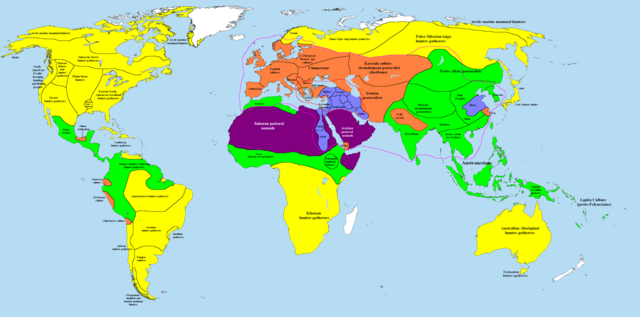
Map of the world in 1000 BC
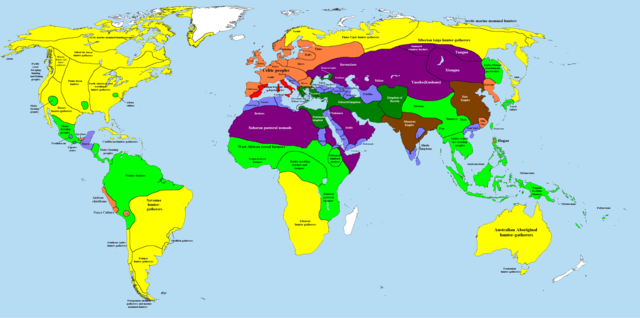
Map of the world in 200 BC
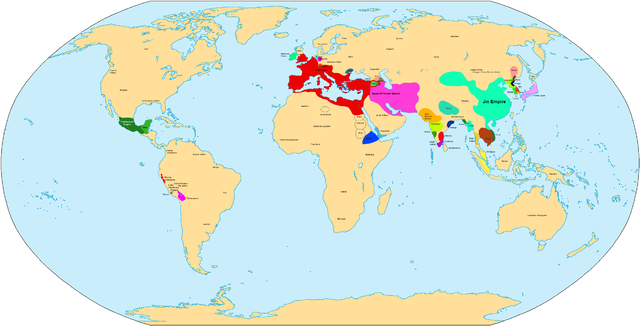
Map of the World in 300 AD
Source :
https://en.wikipedia.org/ |
.jpg)
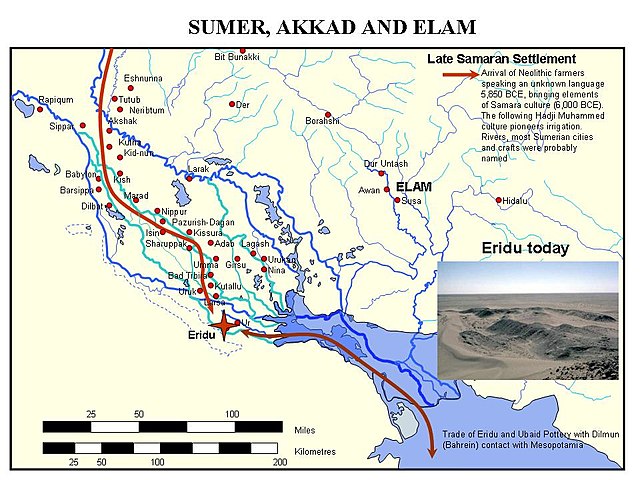
.png)
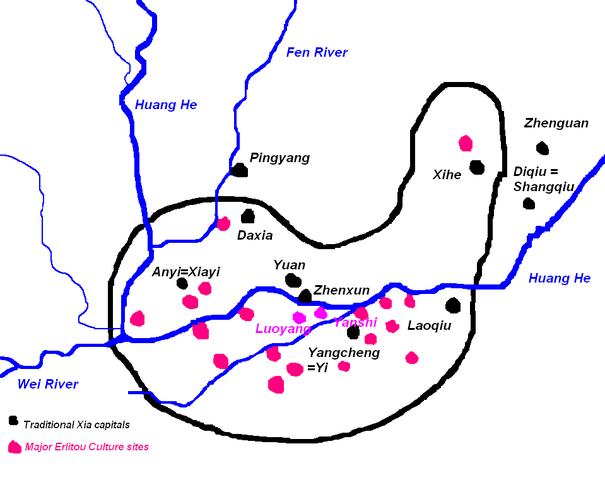
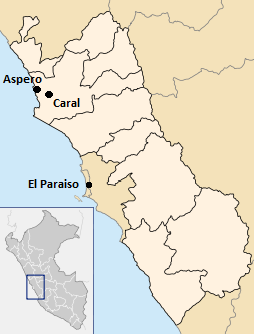
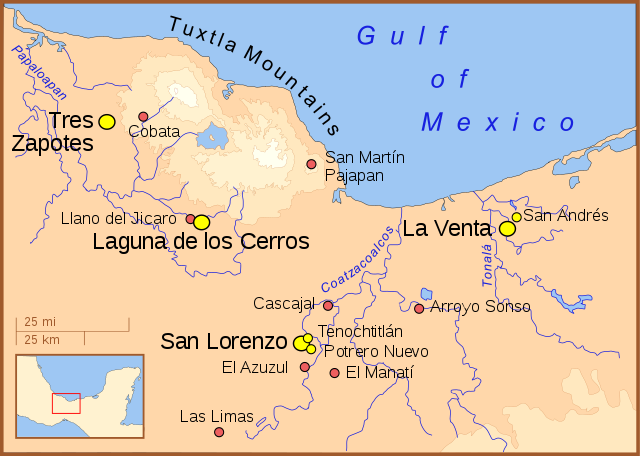
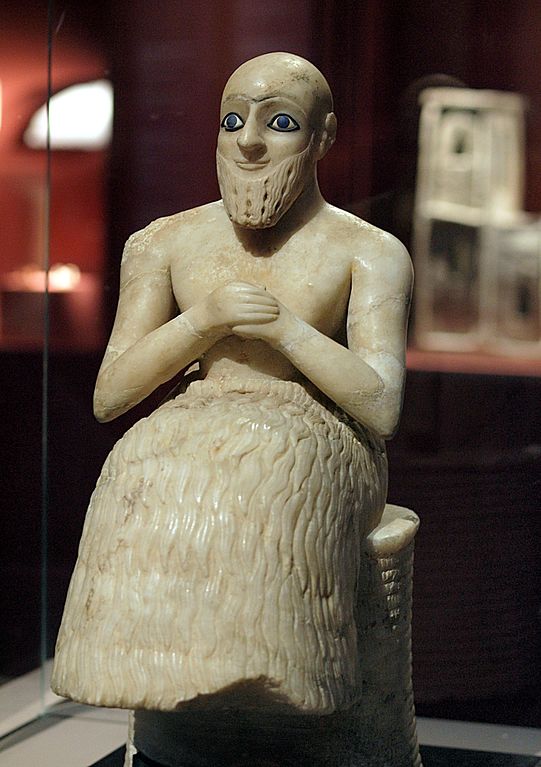
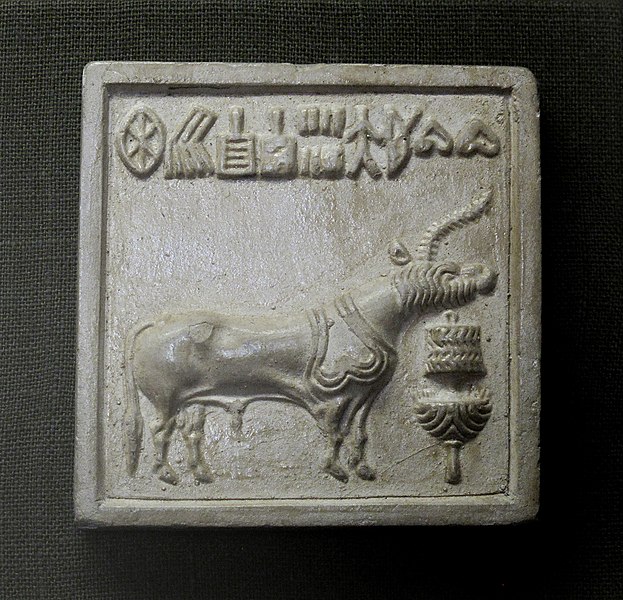
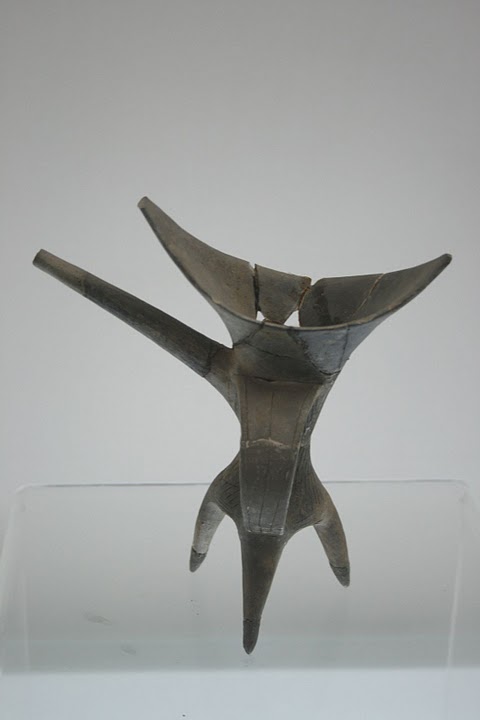
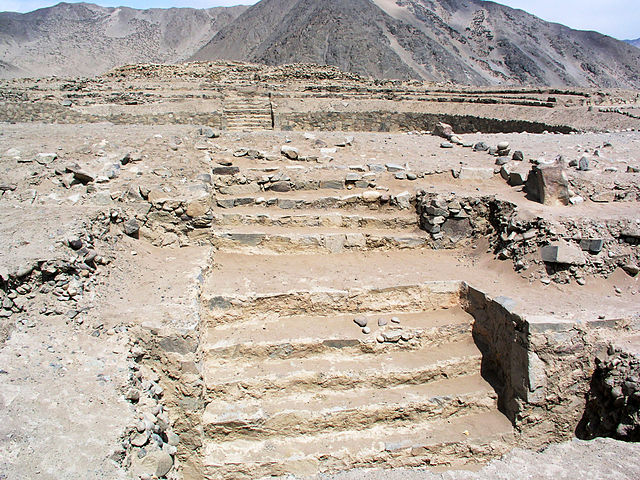
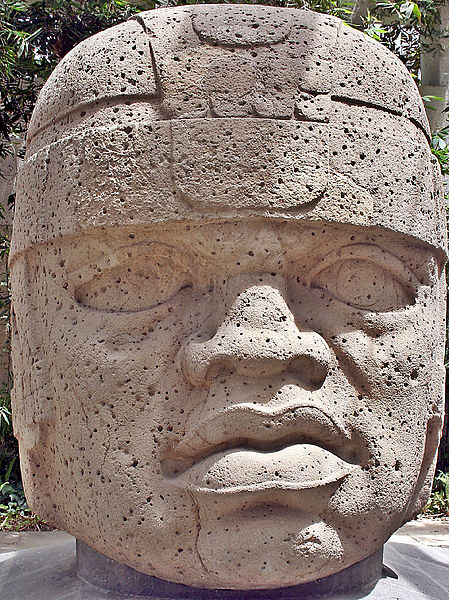
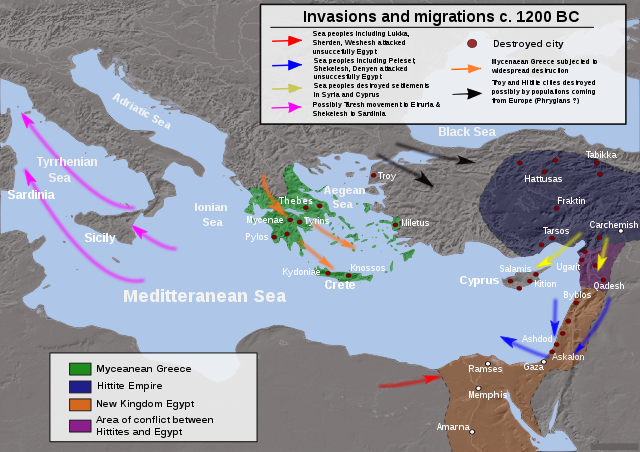
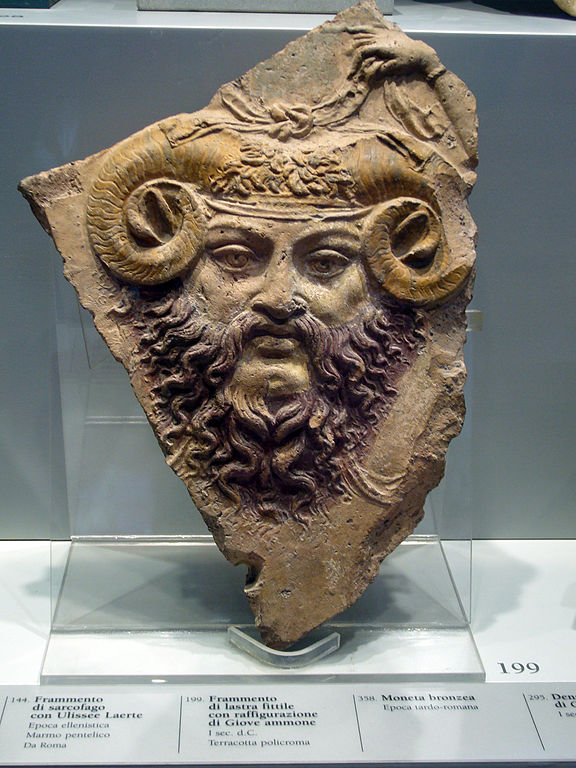

_vector.svg.png)
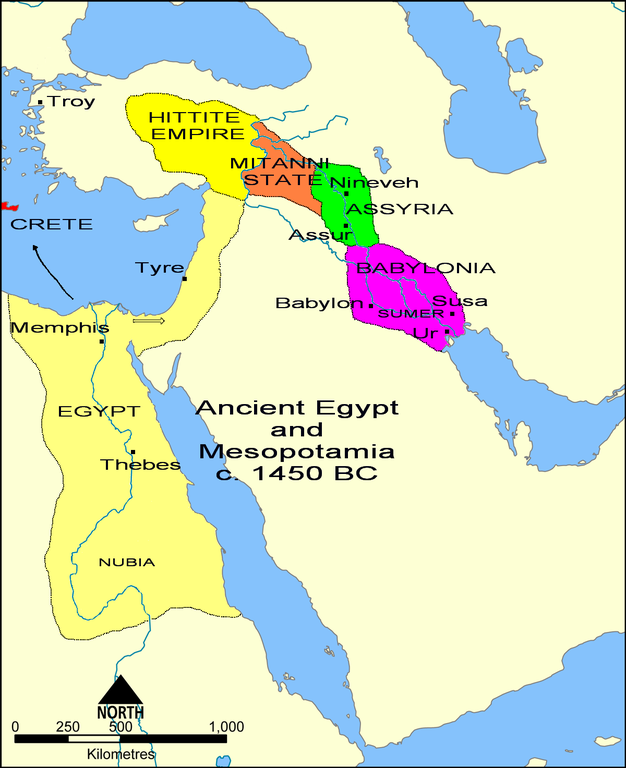
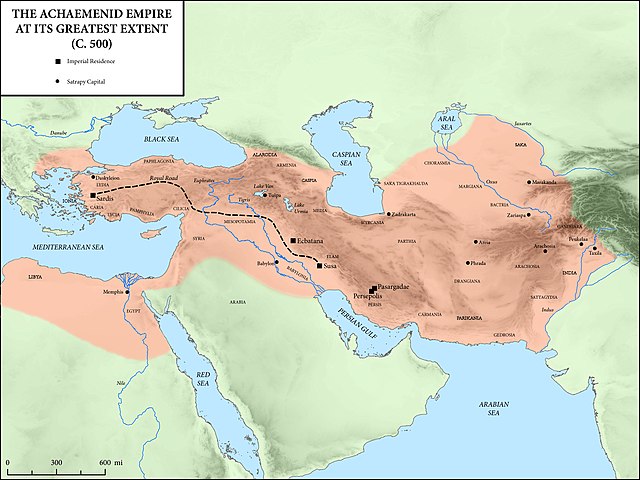
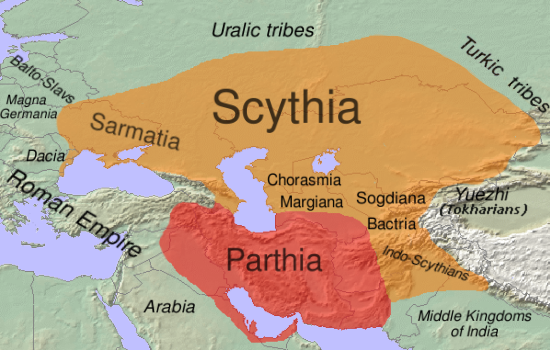
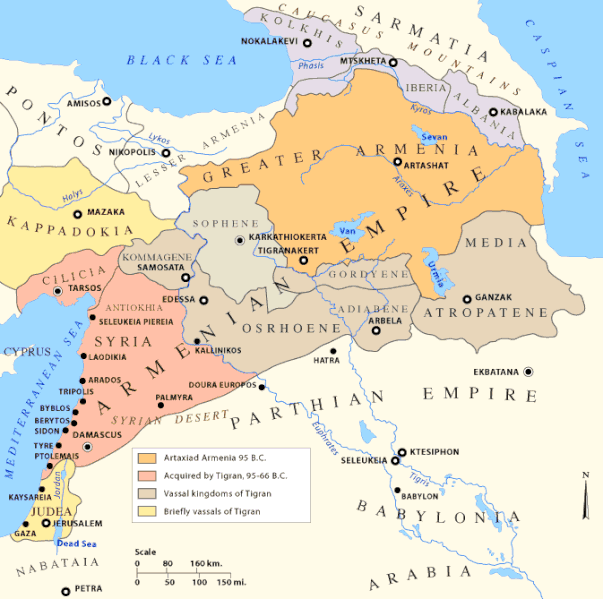
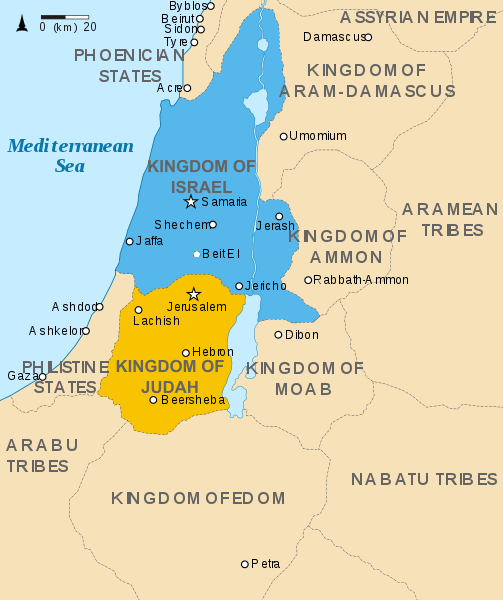
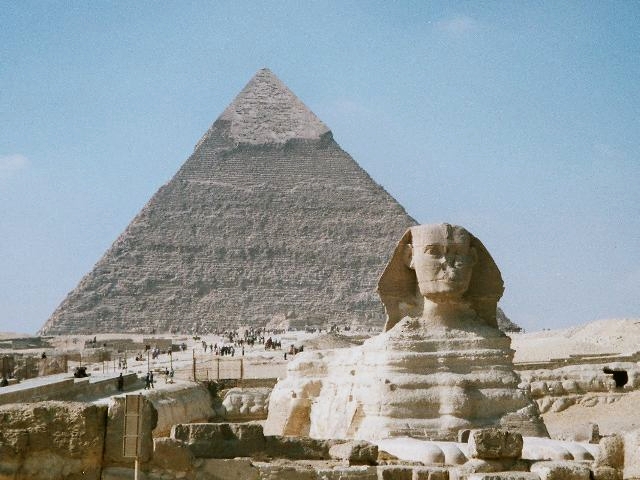
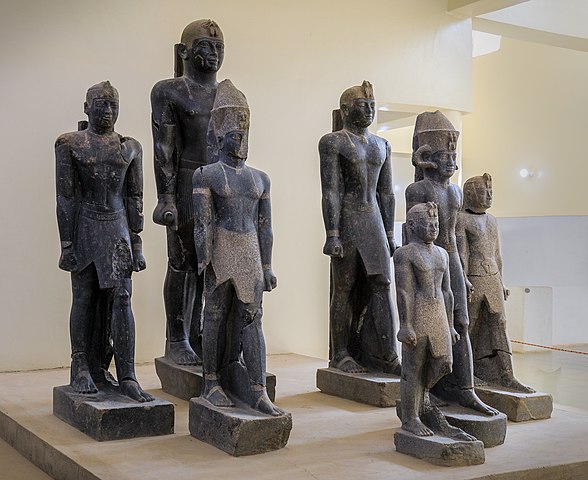
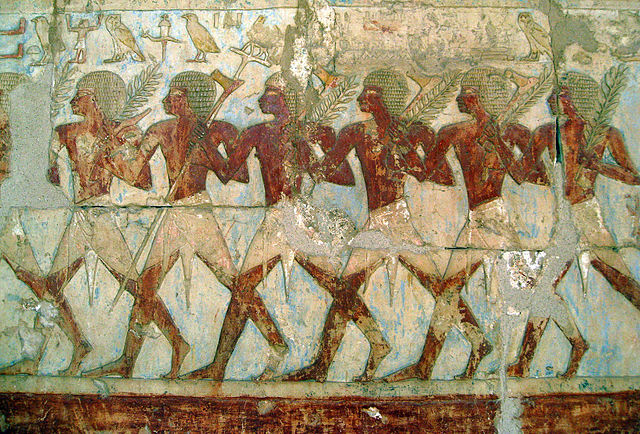
.jpg)
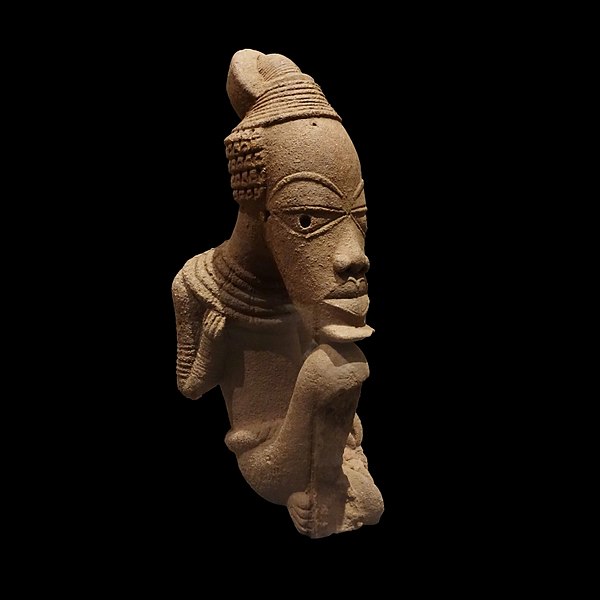
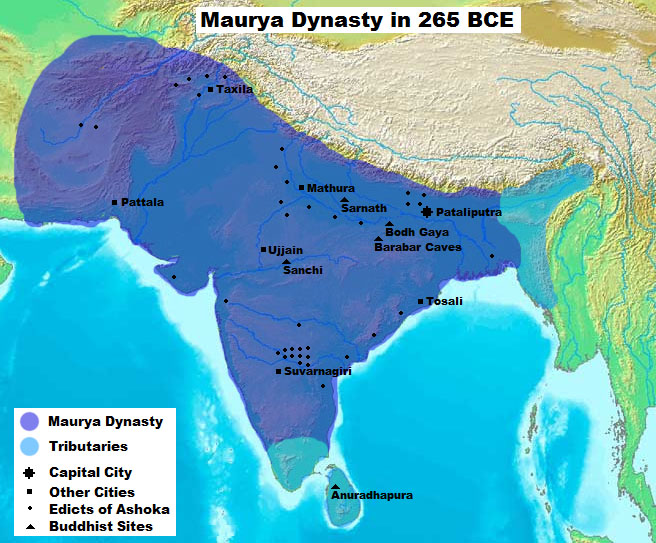
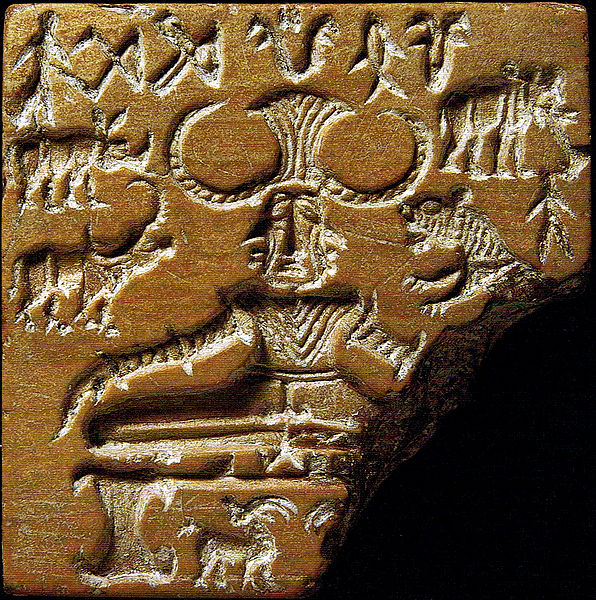
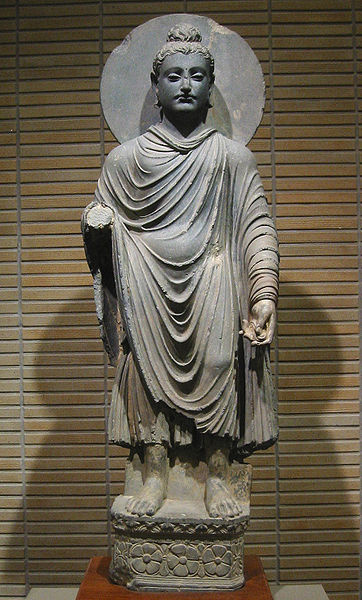
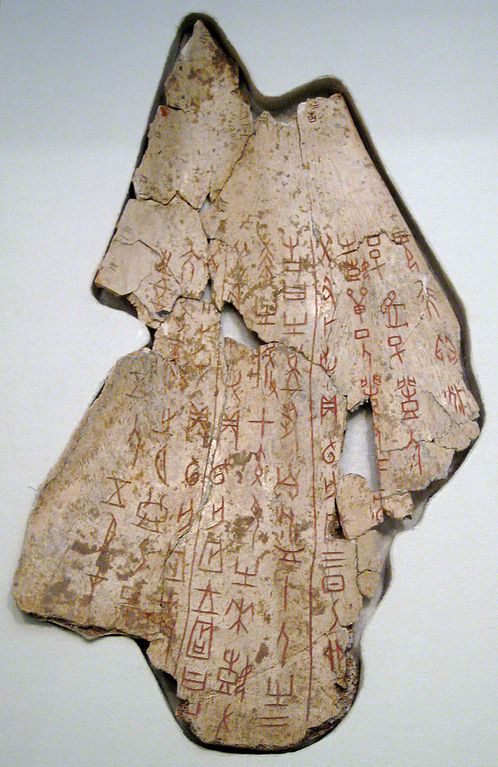
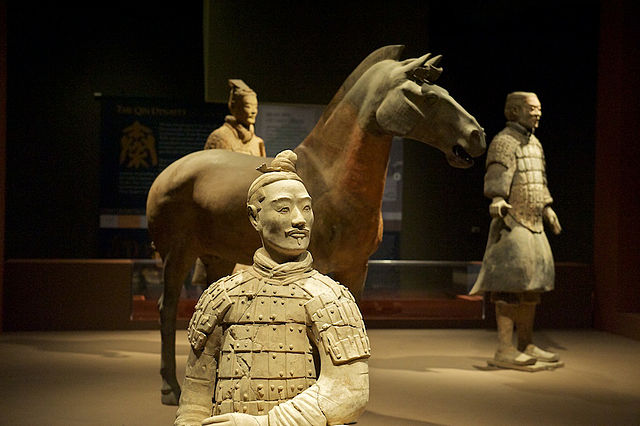
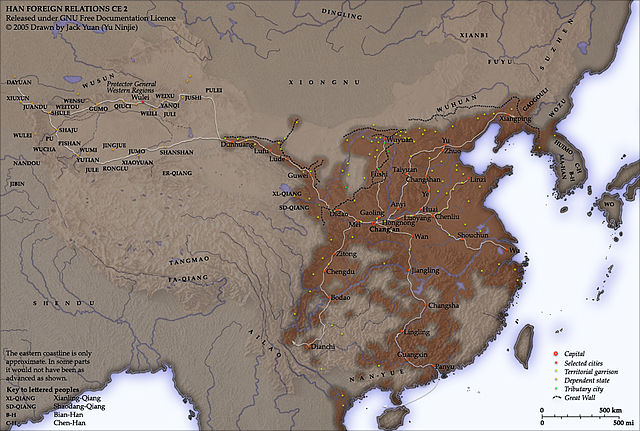
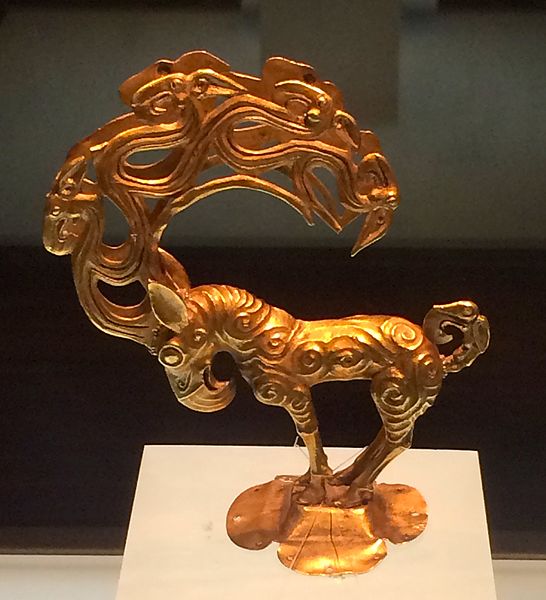
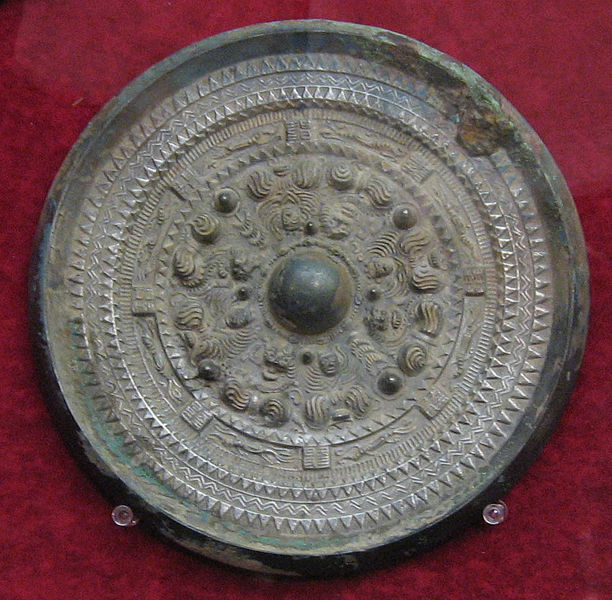
.jpg)
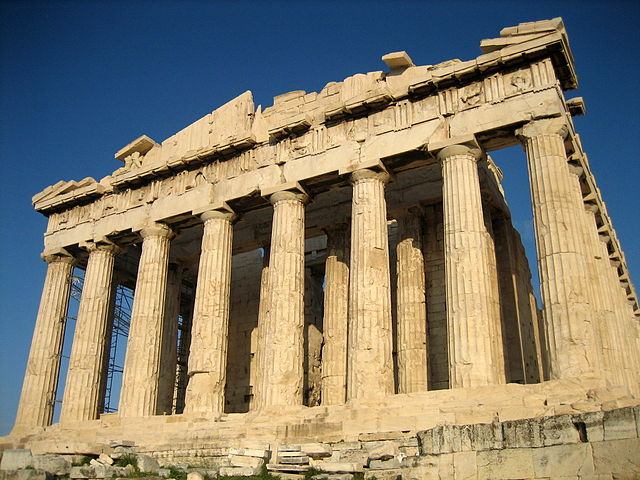
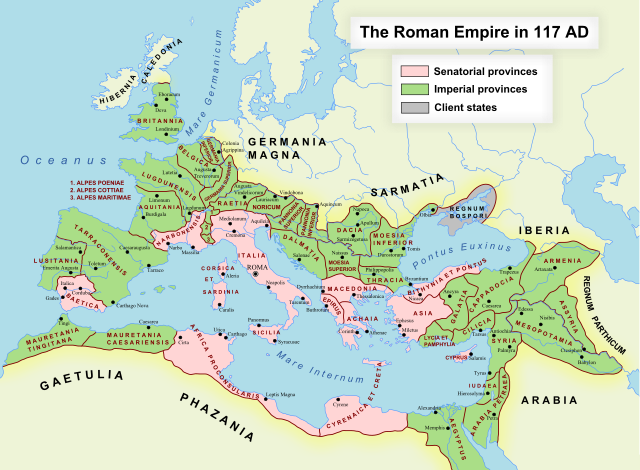
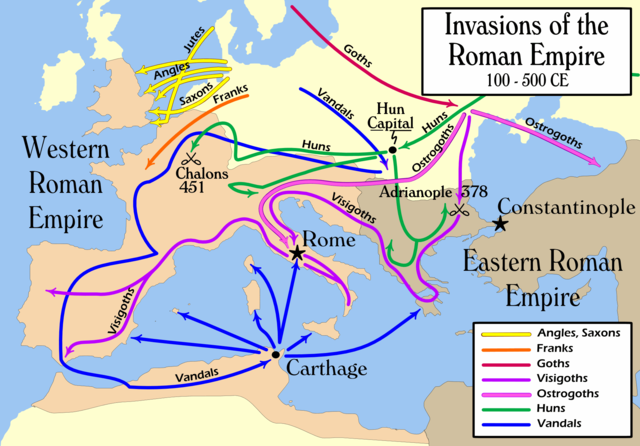
.png)
